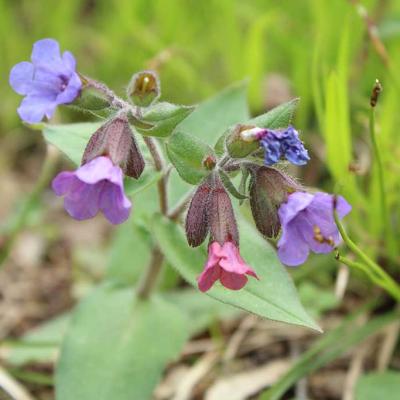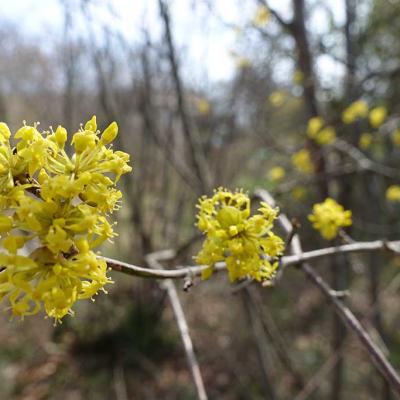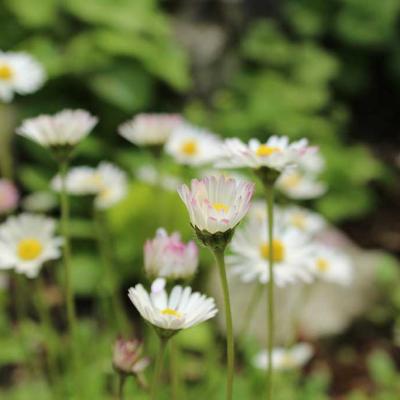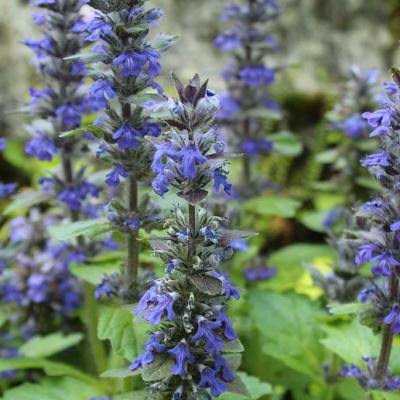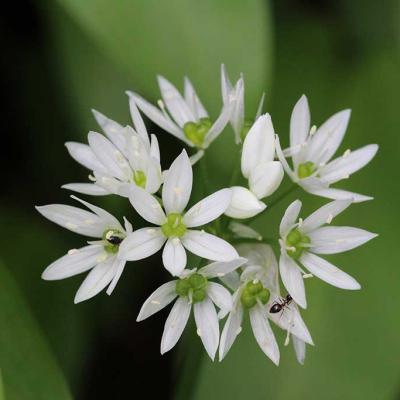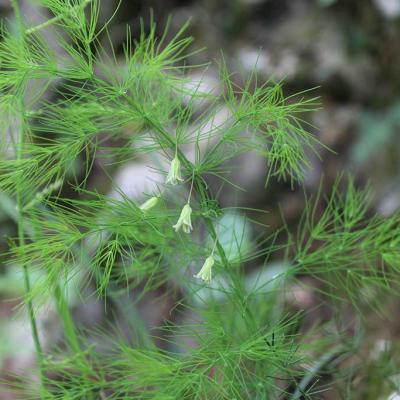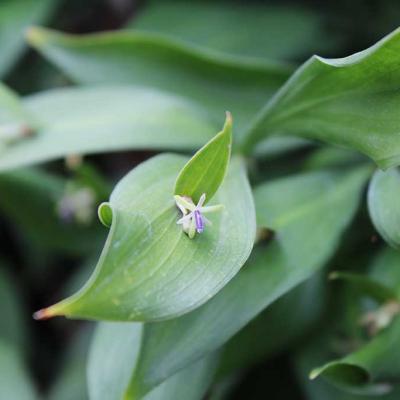Edible plants
Edible plants are wild plant species that were (or still are) a source of calories, nutrients and minerals for humans. Many also contain active ingredients from which a potential therapeutic or medical use derives, for example as mild diuretics, such as the various species of asparagus (Asparagus acutifolius, Asparagus tenuifolius and Asparagus officinalis) or the dandelion (Taraxacum officinale). For millennia these plants supplemented the caloric sources of "domesticated" plant cultivar species (such as wheat or cabbage) or were given to farmed animals such as cows and hens. This was particularly so in times of food shortages, even though the knowledge base was much older, dating back to the hunter-gatherer period of Europe and the beginning of the Neolithic era. In the flowerbeds of the garden we have about thirty species of common use in the Karst.
Below we list and describe some edible plants present in the area of the garden dedicated to them.
Laurel (Laurus nobilis). Even the laurel is not typical of the Karst but is present as it was introduced by humans into domestic spaces and then became naturalised in the inhabited areas especially in the warmer parts of the area. As is well-known, the leaves are used to flavour roasts and other dishes.
Nettle (Urtica dioica). A common species of highly nitrogenous soils, although less widespread than in the past. Cooking eliminates its proverbial stings, present in vivo, and thus the leaves and young shoots are used, preferably before flowering, as an excellent cooked vegetable and in the preparation of soups, omelettes and sauces.
Bugle (Ajuga reptans). A perennial herbaceous plant of the Labiate family. Stoloniferous, it forms populations in rosettes close together and fairly flattened to the ground. It grows in semi-shaded conditions, in light woods on the plains and hills, on wooded edges and in lush meadows. The young inflorescences are used cooked, like wild asparagus, when, in spring, most of the flowers (when ripe, blue in colour and in the shape of a snapdragon) are still in bud.
Plantains (Plantago lanceolata, P. media, P. major). Plants respectively of fairly damp meadows, drier ones and ones with moderately heavily trampled surfaces. The young leaves are eaten raw or cooked together with the still closed inflorescences. If fried, these develop a fungal flavour that can also be perceived raw. The haemostatic effect of the leaf juice is well documented.
Dandelion (Taraxacum officinale). A plant of uncultivated but fertile meadows. The leaves, especially young ones, the inflorescences in bud and fully developed, the floral peduncles, and the receptacles (the “buttons” that have lost their fluff and seeds) can be consumed in various ways and preparations, together with the roots. Among the plant’s many properties, its diuretic and purifying effect are well known. One French name is pissenlit, so beware!
Comfrey (Symphytum officinale). A plant of meadows, at least a little damp, of which the cooked young leaves are mainly used, like spinach but, similarly, also in more elaborate preparations. It should be consumed occasionally and not in large quantities as it contains pyrrolizidine alkaloids.
Dogwood (Cornus mas). A shrub with a very resistant, hard wood that grows on woodland edges and in dry woods. The fresh fruits, scarlet red when ripe and rich in vitamin C, can be used either directly, or in jams and sweet-and-sour. An unusual and pleasant herbal tea can be prepared using the flowers and leaves.
Blackthorn (Prunus spinosa). A thorny shrub of fertile woodland margins in both lowlands and hilly areas, which usually grows in thickets. A relative of the domestic plum tree, the small rounded fruits can be used when overripe (otherwise they are too astringent) or in jams. With the dried leaves you can prepare an unusual and pleasant herbal tea.
Elderberry (Sambucus nigra). A shrub of cool, fertile soils, the cream-white umbrella-shaped inflorescences are used above all as battered pancakes and more famously for preparing a thirst-quenching syrup. Even the fruits can be used for this purpose as for others, but always rigorously cooked, otherwise they are toxic.
Self-heal (Prunella vulgaris). A perennial herbaceous plant of the Labiate family, it is stoloniferous, forming populations in rosettes, variably spaced apart and not flattened to the ground. It grows in semi-shaded conditions, along forest edges and in lush meadows. In spring the young inflorescences are used cooked, like wild asparagus, whenmost of the flowers are still closed.
Wild rocket (Diplotaxis tenuifolia). A perennial herbaceous plant of the Crucifer family, it grows well on loose, sandy-gravel soils in full sun. The leaves and tenderr parts are mainly consumed raw alongside other raw vegetables, as the strong, aromatic and even slightly "peppery" flavour in plants that grow in very sunny positions can make this plant difficult on the palate if consumed by itself.
Sorrel (Rumex acetosa). A perennial herbaceous plant of the Polygonaceae, it grows in lush meadows and its young shoots and arrow-shaped leaves, with a markedly acidic taste to flavour raw in salads, as well as in sauces and smoothies. It should not be consumed to excess due to its oxalic acid content and for this reason it is also not recommended for people with kidney or urinary problems.
Wild strawberry (Fragaria vesca). A perennial herbaceous plant of the Rosaceae family. Reproducing with stolons, it creates small populations mainly along wooded margins. In addition to the famously edible fruits, the leaves and flowers can also be used for the preparation of herbal teas.
Ground ivy (Glechoma hederacea). A perennial herbaceous plant of the Labiate family, with creeping stems, it also forms extensive populations in partially shaded areas such as forest edges. The young leaves and spring shoots can be used as a flavouring. With the leaves you can also make an herbal tea with an unusual flavour.
Wild sage (Salvia pratensis). A perennial herbaceous plant of the Labiate family, with dark purple “lion mouth” flowers, it has an unmistakable aroma when rubbed. The plant grows in meadows and pastures. When dried and chopped, the leaves are used as a spice and the young leaves are used sparingly in salads to flavour them with a rustic and unusual tast. Using the leaves and flowers you can prepare a pleasant herbal tea.
Perennial lettuce (Lactuca perennis). A perennial herbaceous plant of the Asteraceae family with "flowers" similar in shape to those of a dandelion, but a blue-violet in colour. In spring with a crunchy texture and a slightly bitter taste, the young leaves of the basal rosettes can be used raw on their own or mixed with other wild herbs.
Pyramidal bellflower (Campanula pyramidalis). A biennial herbaceous plant of the Campanulaceae family which produces very showy spikes of blue flowers from late summer to autumn, sometimes as much as a couple of metres high. In spring, with their crunchy texture and nutty flavour, the young leaves of the basal rosettes,can be used raw on their own, or mixed with other wild herbs.
Bladder campion (Silene vulgaris). A perennial herbaceous plant of the Cariophyllaceae family, known locally as 'sclopit', it grows in dry meadows and is easily recognized by its swollen, pitcher-shaped flowers. The very young shoots are eaten in spring in omelettes and risottos
Clovers (Trifolium pratense, Trifolium repens, Trifolium rubens) are perennial herbaceous plants. The first two are typical of lush meadows, while the third is found on the woodland edge. The young green parts (inflorescences, shoots) are eaten raw or cooked in soups and salads and other dishes. The inflorescences can be used in herbal teas. Collected during full sunlight, they have a more intense aroma.
Wild garlic (Allium ursinum). This is a wild garlic that grows throughout the spring in cool to moist deciduous woodlands. With a more delicate aroma than cultivated garlic, it can be used in the same fashion. The lanceolate leaves are mainly consumed raw as a salad, mixed with other vegetables, or cooked to flavour omelettes. This is a plant you have to be able to recognize with certainty since it is not difficult to confuse it with toxic species such as Lily-of-the-valley) and even deadly ones such as autumn crocus.
Below we list and describe some edible plants present in the area of the garden dedicated to them.
Laurel (Laurus nobilis). Even the laurel is not typical of the Karst but is present as it was introduced by humans into domestic spaces and then became naturalised in the inhabited areas especially in the warmer parts of the area. As is well-known, the leaves are used to flavour roasts and other dishes.
Nettle (Urtica dioica). A common species of highly nitrogenous soils, although less widespread than in the past. Cooking eliminates its proverbial stings, present in vivo, and thus the leaves and young shoots are used, preferably before flowering, as an excellent cooked vegetable and in the preparation of soups, omelettes and sauces.
Bugle (Ajuga reptans). A perennial herbaceous plant of the Labiate family. Stoloniferous, it forms populations in rosettes close together and fairly flattened to the ground. It grows in semi-shaded conditions, in light woods on the plains and hills, on wooded edges and in lush meadows. The young inflorescences are used cooked, like wild asparagus, when, in spring, most of the flowers (when ripe, blue in colour and in the shape of a snapdragon) are still in bud.
Plantains (Plantago lanceolata, P. media, P. major). Plants respectively of fairly damp meadows, drier ones and ones with moderately heavily trampled surfaces. The young leaves are eaten raw or cooked together with the still closed inflorescences. If fried, these develop a fungal flavour that can also be perceived raw. The haemostatic effect of the leaf juice is well documented.
Dandelion (Taraxacum officinale). A plant of uncultivated but fertile meadows. The leaves, especially young ones, the inflorescences in bud and fully developed, the floral peduncles, and the receptacles (the “buttons” that have lost their fluff and seeds) can be consumed in various ways and preparations, together with the roots. Among the plant’s many properties, its diuretic and purifying effect are well known. One French name is pissenlit, so beware!
Comfrey (Symphytum officinale). A plant of meadows, at least a little damp, of which the cooked young leaves are mainly used, like spinach but, similarly, also in more elaborate preparations. It should be consumed occasionally and not in large quantities as it contains pyrrolizidine alkaloids.
Dogwood (Cornus mas). A shrub with a very resistant, hard wood that grows on woodland edges and in dry woods. The fresh fruits, scarlet red when ripe and rich in vitamin C, can be used either directly, or in jams and sweet-and-sour. An unusual and pleasant herbal tea can be prepared using the flowers and leaves.
Blackthorn (Prunus spinosa). A thorny shrub of fertile woodland margins in both lowlands and hilly areas, which usually grows in thickets. A relative of the domestic plum tree, the small rounded fruits can be used when overripe (otherwise they are too astringent) or in jams. With the dried leaves you can prepare an unusual and pleasant herbal tea.
Elderberry (Sambucus nigra). A shrub of cool, fertile soils, the cream-white umbrella-shaped inflorescences are used above all as battered pancakes and more famously for preparing a thirst-quenching syrup. Even the fruits can be used for this purpose as for others, but always rigorously cooked, otherwise they are toxic.
Self-heal (Prunella vulgaris). A perennial herbaceous plant of the Labiate family, it is stoloniferous, forming populations in rosettes, variably spaced apart and not flattened to the ground. It grows in semi-shaded conditions, along forest edges and in lush meadows. In spring the young inflorescences are used cooked, like wild asparagus, whenmost of the flowers are still closed.
Wild asparagus (Asparagus acutifolius, A. tenuifolius and butcher's broom Ruscus aculeatus). Semi-bushy plants (chamaephytes) of the Asparagaceae family. They are all associated with forest or forest edge habitats. The young spring shoots that emerge from the ground between the adult stems are eaten cooked, before they begin to branch out and harden.
Ground-elder (Aegopodium podagraria). A perennial herbaceous plant of the Apiaceae family, it reproduces via stolons, creating generally fairly dense populations in humid to very cool woods (and hedges). All the aerial parts of the plant can be consumed in spring, both raw (when particularly young) and cooked, before the appearance of the small white flowers collected in umbels. It is a vegetable with aromatic hints reminiscent of carrot. Gatherers need to be certain of the identification of the plant as some very toxic species are included among the Apiaceae.
Ground-elder (Aegopodium podagraria). A perennial herbaceous plant of the Apiaceae family, it reproduces via stolons, creating generally fairly dense populations in humid to very cool woods (and hedges). All the aerial parts of the plant can be consumed in spring, both raw (when particularly young) and cooked, before the appearance of the small white flowers collected in umbels. It is a vegetable with aromatic hints reminiscent of carrot. Gatherers need to be certain of the identification of the plant as some very toxic species are included among the Apiaceae.
Common burdock (Actium lappa). A biennial herbaceous plant of the Asteraceae family. It grows along the edges of woods and bushy field margins and roads in similar settings, etc. Its life cycle lasts two years, with a new seedling germinating, in the first year it produces only a rosette of large leaves. During the second year a stem develops from this rosette on which, after flowering, are the fruits and seeds and the individual plant then dies. The plants are edible, including the root at the end of its first year and then, in the spring of the second year, both the leaf petioles and the peeled stem, after cooking.
Wild rocket (Diplotaxis tenuifolia). A perennial herbaceous plant of the Crucifer family, it grows well on loose, sandy-gravel soils in full sun. The leaves and tenderr parts are mainly consumed raw alongside other raw vegetables, as the strong, aromatic and even slightly "peppery" flavour in plants that grow in very sunny positions can make this plant difficult on the palate if consumed by itself.
Sorrel (Rumex acetosa). A perennial herbaceous plant of the Polygonaceae, it grows in lush meadows and its young shoots and arrow-shaped leaves, with a markedly acidic taste to flavour raw in salads, as well as in sauces and smoothies. It should not be consumed to excess due to its oxalic acid content and for this reason it is also not recommended for people with kidney or urinary problems.
Wild strawberry (Fragaria vesca). A perennial herbaceous plant of the Rosaceae family. Reproducing with stolons, it creates small populations mainly along wooded margins. In addition to the famously edible fruits, the leaves and flowers can also be used for the preparation of herbal teas.
Ground ivy (Glechoma hederacea). A perennial herbaceous plant of the Labiate family, with creeping stems, it also forms extensive populations in partially shaded areas such as forest edges. The young leaves and spring shoots can be used as a flavouring. With the leaves you can also make an herbal tea with an unusual flavour.
Wild sage (Salvia pratensis). A perennial herbaceous plant of the Labiate family, with dark purple “lion mouth” flowers, it has an unmistakable aroma when rubbed. The plant grows in meadows and pastures. When dried and chopped, the leaves are used as a spice and the young leaves are used sparingly in salads to flavour them with a rustic and unusual tast. Using the leaves and flowers you can prepare a pleasant herbal tea.
Perennial lettuce (Lactuca perennis). A perennial herbaceous plant of the Asteraceae family with "flowers" similar in shape to those of a dandelion, but a blue-violet in colour. In spring with a crunchy texture and a slightly bitter taste, the young leaves of the basal rosettes can be used raw on their own or mixed with other wild herbs.
Pyramidal bellflower (Campanula pyramidalis). A biennial herbaceous plant of the Campanulaceae family which produces very showy spikes of blue flowers from late summer to autumn, sometimes as much as a couple of metres high. In spring, with their crunchy texture and nutty flavour, the young leaves of the basal rosettes,can be used raw on their own, or mixed with other wild herbs.
Bladder campion (Silene vulgaris). A perennial herbaceous plant of the Cariophyllaceae family, known locally as 'sclopit', it grows in dry meadows and is easily recognized by its swollen, pitcher-shaped flowers. The very young shoots are eaten in spring in omelettes and risottos
Clovers (Trifolium pratense, Trifolium repens, Trifolium rubens) are perennial herbaceous plants. The first two are typical of lush meadows, while the third is found on the woodland edge. The young green parts (inflorescences, shoots) are eaten raw or cooked in soups and salads and other dishes. The inflorescences can be used in herbal teas. Collected during full sunlight, they have a more intense aroma.
Wild garlic (Allium ursinum). This is a wild garlic that grows throughout the spring in cool to moist deciduous woodlands. With a more delicate aroma than cultivated garlic, it can be used in the same fashion. The lanceolate leaves are mainly consumed raw as a salad, mixed with other vegetables, or cooked to flavour omelettes. This is a plant you have to be able to recognize with certainty since it is not difficult to confuse it with toxic species such as Lily-of-the-valley) and even deadly ones such as autumn crocus.

